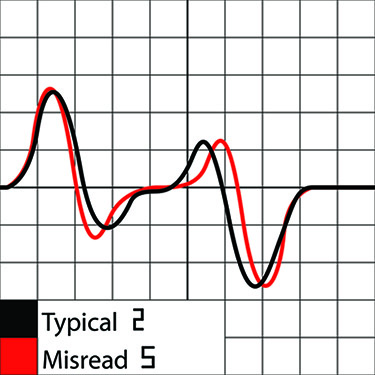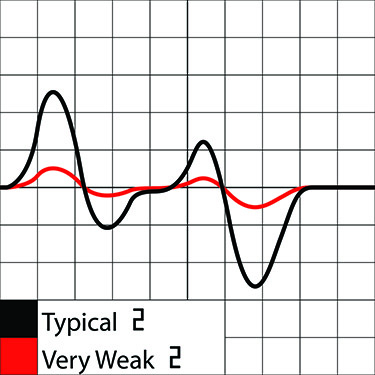If you read the previous article in our series about magnetic printing on checks, then you’ve already got a basic understanding of how MICR reading works, and of the differences between the two main types of fonts used on checks. To recap briefly:
- MICR readers don’t “see” the characters; only the amount of magnetic signal present in a vertical line at any given point;
- The odd print styles of MICR fonts are designed to give each character a distinctive signal shape;
- For the E13B font used in North America, the shape is a wave with at least two peaks and valleys; for the CMC7 font used in Europe and elsewhere, the shape is a bar code that is either “on” or “off,” creating at least seven peaks and valleys.
While there’s no particular international agreement on the matter, the geographic usage of E13B and CMC7 has fallen out along many regional and some historical lines: E13B is used by many former British protectorates including the U.S., Canada, Australia, and the U.K itself (as well as Central America and much of Asia), while CMC7 is prevalent in South America, most of the rest of Europe, and various other scattered locations around the globe. Whether this was a calculated move or pure coincidence is anyone’s best guess.
At any rate, while each font has its own odd, distinctive appearance, in many respects the two couldn’t be much more different from each other:


So why have some countries gone with one, and some with the other? Does one have a particular advantage?
To be sure, the barcode format of CMC7 definitely does help with one of the main things it was designed to do, which is to prevent mix-ups between characters. It may not be obvious to the human eye, but a few character pairs in the E13B font (most notably the 2 and the 5) share very similar patterns if you are just looking at the amount of ink from left to right and the corresponding change in signal strength that it generates.
So if anything goes wrong – if the speed of the document or the spacing of the characters is a little off, for example; or if the magnetic ink is not the right strength – it’s possible to confuse one for the other.

With CMC7, on the other hand, there’s no such room for misinterpretation; every character has two distinct large gaps in different places, as well as distinct patterns in between to minimize any chance for confusion.
On the other hand, the CMC7 font has a few issues of its own, mostly because of the tiny spaces between lines in the barcode. For one, that makes it highly dependent on EXACT speed and positioning. If the paper is pulled through the feeder even a little bit unevenly, it can cause two lines to look like one line, or a small gap to look like a big gap, resulting in a can’t-read or even a character substitution. Or, if the spacing of the characters wasn’t perfect during the printing process, the same kinds of errors can crop up. One other interesting phenomenon of note: If read backwards, it’s possible for CMC7 to produce what seems like a valid result, only with every character incorrect.
But perhaps the main headache from CMC7 comes when it’s time to apply Optical Character Recognition (OCR) – a more recent technique that uses software to visually identify each character, and which is often used as a backup method of verifying that the MICR characters are correct. The lines in the CMC7 barcode are so thin and so close together that they blend together at the resolution of 200 dots per inch (dpi), which is the “official” required format in many countries.
Most check scanners today capture raw images at 300 dpi, or even 600 dpi, and then downgrade them to 200 dpi as needed; so there is a small window of time at the very start where it might be possible to use OCR at full effectiveness. But once the image is downgraded, it’s gone.

A weak magnetic signal will trigger OCR as a backup.
While difficulty with OCR may not be a huge problem ordinarily – after all, it’s only a backup to the magnetic reader – it can become an issue due to the huge difference in equipment and printed documents in different places around the world. Certain countries, for example, suffer from extreme variations in the print quality of their checks, which throws off the MICR signal strength. Others have few or no standards for check formats and backgrounds, leading to possible interference.
So the bottom line is that, while better in theory, CMC7 does run into certain practical issues that keep its effectiveness roughly on par with that of E13B.
But does every country NEED to make an either/or choice between E13B and CMC7? Would it be possible to make scanners accommodate both? Well, yes and no.
There is only one place in the world where both fonts are used at once: Israel, where the Israelis made CMC7 their official standard, while the Palestinians opted for E13B. Bank scanning equipment there has to account for both fonts, which has had two main visible results:
- Software providers hate it; and
- The recognition success rate drops significantly.
Why does the success rate drop? As we mentioned earlier, OCR is used to double-check any time there’s a question about a MICR character – and when you’re checking OCR against two different sets of characters, your odds of a mismatch go up slightly. The combination of magnetic and optical recognition is usually good for a success rate of well over 99 percent. In the dual-MICR, dual-OCR environment of Israel, that goes down 1 or 2 percent, and tends to be more like 97 or 98 percent.
Just to clarify: The lower success rate doesn’t have to do with the MICR part of the scan – the magnetic differences between E13B and CMC7 are so vast that it is impossible to confuse one for the other, so the MICR read rate remains the same. It’s the OCR assist that runs into trouble with two different visual character sets. (Most of the drop in read rate, it should be noted, comes from checks that have low MICR strength to begin with, thereby triggering the OCR comparison, which is correct less often.)
At any rate, 97 or 98 percent may still be pretty good, but multiplied by millions and millions of checks, it’s a lot of work for someone to sort through them manually. But since CMC7 and E13B don’t overlap outside of one country, most of the world thankfully does not need to worry itself with that potential conflict.





